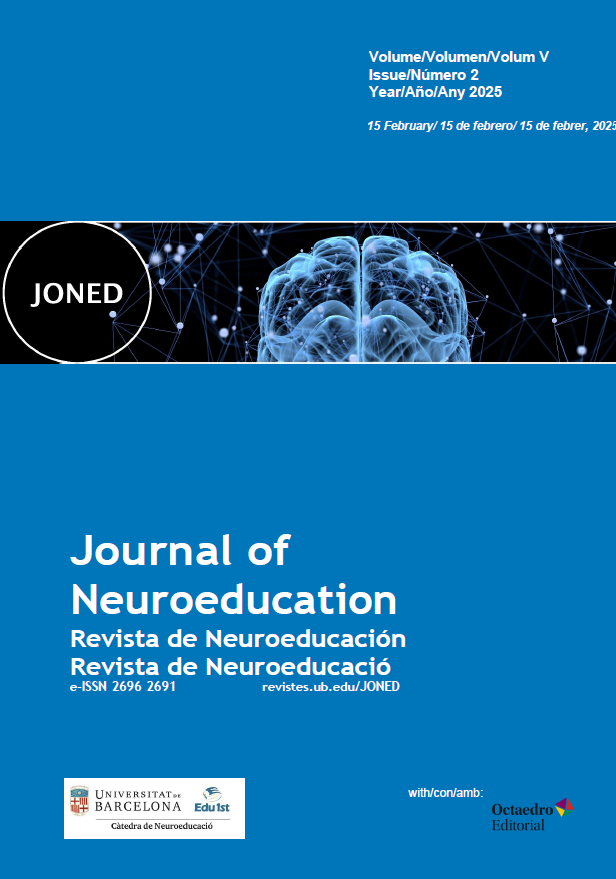Perspectives Of Brain Research (Educational Neuroscience) on the Design and Implementation of Teaching Strategies in Educational Technology
DOI:
https://doi.org/10.1344/joned.v5i2.47695Palabras clave:
neurociencias educativas, estrategias de enseñanza, EdTechResumen
La integración de la neurociencia educativa y la tecnología educativa propicia la generación de nuevas perspectivas para optimizar la comprensión y la eficiencia de los métodos pedagógicos. Mediante el análisis del compromiso cerebral con diversas tecnologías educativas, los educadores pueden formular estrategias de instrucción más eficaces, adaptadas a las necesidades específicas de los estudiantes. Esta metodología tiene el potencial de propiciar mejoras significativas en el desempeño académico y proporcionar experiencias de aprendizaje diversas y completas. Este estudio examina el impacto de los descubrimientos de la neurociencia educativa en la formulación y puesta en práctica de estrategias pedagógicas en el contexto de la tecnología educativa. Se realiza un análisis de la integración de la tecnología educativa con principios de neurociencia educativa y se realiza un contraste entre las teorías de aprendizaje tradicionales y las fundamentadas en la neurociencia. Presenta pruebas empíricas que corroboran la optimización de los resultados de aprendizaje mediante metodologías pedagógicas fundamentadas en la neurociencia, al igual que los retos y restricciones asociados con la implementación de la neurociencia educativa en el ámbito tecnológico educativo.
Citas
Gkintoni, E., Dimakos, I., Halkiopoulos, C., & Antonopoulou, H. (2023). Contributions of neuroscience to educational praxis: A systematic review. Emerging Science Journal, 7, 146–158.
Tan, Y., & Amiel, J. (2019). Teachers learning to apply neuroscience to classroom instruction: Case of professional development in British Columbia. Professional Development in Education, 48(1), 70–87. https://doi.org/10.1080/19415257.2019.1689522
Bhargava, A., & Ramadas, V. (2022). Implications of neuroscience/neuroeducation in the field of education to enhance the learning outcomes of the students. Journal of Positive School Psychology, 6(6), 6502–6510.
Cearon, I., & Feltes, H. (2020). Neuroscience role in the foreign language teaching and learning. Ciência & Cognição, 25(1), 43–60.
Rosa-Salva, O., Mayer, U., Versace, E., Hébert, M., Lemaire, B. S., & Vallortigara, G. (2021). Sensitive periods for social development: Interactions between predisposed and learned mechanisms. Cognition, 213, 104552.
Nykyporets, S., Melnyk, O., Hadaichuk, N., Derun, V., & Chopliak, V. (2023). Neuropedagogical approach enhancing foreign language acquisition in non-linguistic higher education institutions. Актуальні питання у сучасній науці, 5, 341–355.
Fragkaki, M., Mystakidis, S., & Dimitropoulos, K. (2022). Higher education faculty perceptions and needs on neuroeducation in teaching and learning. Education Sciences, 12(10), 707.
Millei, Z., & Petersen, E. (2022). Psychology, psychiatry and neuroscience in education.
Marshall, L., & Bolt-Lee, C. (2022). A neuroeducation and cognitive learning-based strategy to develop active learning pedagogies for accounting education. Accounting Education Journal, 32.
Dubinsky, J. M., Roehrig, G., & Varma, S. (2013). Infusing neuroscience into teacher professional development. Educational Researcher, 42(6), 317–329. https://doi.org/10.3102/0013189X13499403
Britto, P. R., Yoshikawa, H., & Boller, K. (2011). Quality of early childhood development programs and policies in global contexts: Rationale for investment, conceptual framework and implications for equity. Social Policy Report, 25(2), 1–31.
Tominey, S. L., & McClelland, M. M. (2011). Red light, purple light: Findings from a randomized trial using circle time games to improve behavioral self-regulation in preschool. Early Education and Development, 22(3), 489–519. https://doi.org/10.1080/10409289.2011.574258
Diamond, A., & Lee, K. (2011). Interventions shown to aid executive function development in children 4 to 12 years old. Science, 333(6045), 959–964. https://doi.org/10.1126/science.1204529
Engle, P. L., Fernald, L. C. H., Alderman, H., Behrman, J., & O’Gara, C. (2011). Strategies for reducing inequalities and improving developmental outcomes for young children in low-income and middle-income countries. The Lancet, 378(9799), 1339–1353. https://doi.org/10.1016/S0140-6736(11)60889-1
Aboud, F. E., & Yousafzai, A. K. (2015). Global health and development in early childhood. Annual Review of Psychology, 66, 433–457. https://doi.org/10.1146/annurev-psych-010814-015128
Cowan, N. (2014). Working memory underpins cognitive development, learning, and education. Educational Psychology Review, 26(2), 197–223. https://doi.org/10.1007/s10648-013-9246-y
Sánchez-Sordo, J. M., & Teodoro-Vite, S. (2024). bRAin: Augmented reality brain model for teaching memory disorders to psychology students. Journal of Neuroeducation, 5(1). https://doi.org/10.1344/joned.v5i1.45812
Halkiopoulos, C., & Gkintoni, E. (2024). Leveraging AI in E-Learning: Personalized learning and adaptive assessment through cognitive neuropsychology. A systematic analysis. Electronics, 13(18), 3762. https://doi.org/10.3390/electronics13183762
Hattie, J., & Yates, G. (2014). Visible learning and the science of how we learn. Routledge.
Tyng, C. M., Amin, H. U., Saad, M. N. M., & Malik, A. S. (2017). The influences of emotion on learning and memory. Frontiers in Psychology, 8, 1454. https://doi.org/10.3389/fpsyg.2017.01454
Munakata, Y., Casey, B. J., & Diamond, A. (2004). Developmental cognitive neuroscience: Progress and potential. Trends in Cognitive Sciences, 8(3), 122–128. https://doi.org/10.1016/j.tics.2004.01.005
Kübler, A., & Zander, T. O. (2021). Brain-computer interfaces for neuroadaptive learning. Frontiers in Human Neuroscience, 15, 666642. https://doi.org/10.3389/fnhum.2021.666642
Holmes, W., Bialik, M., & Fadel, C. (2019). Artificial intelligence in education: Promises and implications for teaching and learning. Center for Curriculum Redesign.
Luckin, R., Holmes, W., Griffiths, M., & Forcier, L. B. (2016). Intelligence unleashed: An argument for AI in education. Pearson Education.
Descargas
Publicado
Número
Sección
Licencia
Derechos de autor 2025 sani alkhassawneh, Houria Al Sharif

Esta obra está bajo una licencia internacional Creative Commons Atribución-NoComercial 4.0.
Los autores que publican en esta revista aceptan los siguientes términos:
a. Los autores conservan los derechos de autor y otorgan a la revista el derecho de la primera publicación.
b. Los textos se publicarán bajo una Licencia de Atribución No Comercial Creative Commons que permite a otros compartir el trabajo, siempre que incluyan un reconocimiento de la autoría del trabajo, su publicación inicial en esta revista y los términos de la licencia, y no se haga un uso comercial.



